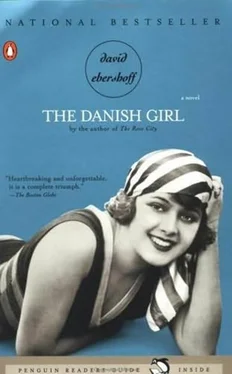“Have you been here long?” Greta now asked Lili.
“Less than an hour.” The needles continued to click in her lap. “I went out. I walked through Kongens Have and crocheted on a bench. Have you seen the roses yet?”
“Do you think it’s a good idea? For you to be outside? All alone?”
“I wasn’t alone,” Lili said. “Henrik met me. He met me on the bench.”
“Henrik,” Greta said. “I see.” Through the corner of her eye, Greta studied her husband. She had no idea what he wanted from this, from Lili, and yet there he was, dressed in a brown skirt and a white blouse with capped sleeves and the old-fashioned shoes with the pewter buckles she had given him that first day. Yes, there he was. A vague regret filled Greta’s throat: she wished she were both more and less involved in the comings and goings of Lili. Greta realized she would never know what exactly was the right thing for her to do.
“How is the fish painter?” Greta asked.
Lili sat forward in her chair and began to tell the story of Henrik’s recent trip to New York, where he dined with Mrs. Rockefeller. “He’s becoming an important painter,” Lili went on, describing the people in the art world who were talking about Henrik. “Did you know he’s an orphan?” Lili said, describing his youth as a sailor’s apprentice on a schooner that fished the North Sea. Lili then reported that Henrik had declared, on the bench in Kongens Have in front of the boxhedge, that he ’d never met a girl like Lili.
“It’s clear he’s taken by you.” Greta could see the heat in Lili’s face. Greta had just returned from an uneventful day at the gallery, her ten paintings all on the wall and unsold. Now all of this-the sight of her husband in the plain brown skirt; the story of Henrik receiving an invitation to dine with Mrs. Rockefeller at the National Arts Club on Gramercy Park; the strange thought of Lili and Henrik on a public bench in the shadow of Rosenborg Slot’s turrets-caught up with her. Greta suddenly asked, “Tell me, Lili. Have you ever kissed a man?”
Lili stopped, her lace limp in her lap.
It was almost as if the question had tumbled with its own will out of Greta’s mouth. She had never wondered about this before, because Einar had always been sexually awkward and without initiative. It seemed impossible to Greta that he would have ever pursued such a foreign longing. Why, without her, Einar would never have found Lili. “Would Henrik be the first?” Greta said. “The first to kiss you?”
Lili thought about this, her brow bunching up. Through the floorboards came the potato-vodka voice of the sailor. “Don’t lie to me!” he was yelling. “I can tell when you’re lying to me.”
“In Bluetooth,” Lili began, “there was a boy named Hans.” It was the first Greta had heard of Hans. Lili spoke of him ecstatically, with her fingers pressed together and held up in the air. It was as if she were in a trance as she told Greta of Hans’s climbing tricks on the ancient oak, of his pebbly little voice, of his submarine-shaped kite sinking into the bog.
“And you haven’t heard from him since?” Greta asked.
“I understand he’s moved to Paris,” Lili said, resuming her crocheting. “He’s an art dealer, but that’s all I know. Deals in art for Americans.” Then she rose and went into the bedroom, where Edvard IV was growling in his sleep, and shut the door. An hour later, when Einar emerged, it was as if Lili had never been there. Except for the scent of mint and milk, it was as if she didn’t really exist at all.
By the end of the two weeks none of Greta’s paintings had sold. She could no longer blame her lack of success on the economy, what with the Great War seven years in the past and the Danish economy chugging and panting with growth and speculation. But the failed show didn’t surprise her. Since they had married, Einar’s reputation had overshadowed hers. His little dark paintings of moors and storms-really, some were no more than gray paint on black-earned more and more kroner each year. Meanwhile Greta sold nothing but the drab commissions of corporate directors who refused to crack a smile. The more personal portraits she painted-of Anna, of the blind woman at the gate of Tivoli, and now of Lili-went unnoticed. After all, who would buy Greta’s work over Einar’s, the bright, bold American’s over the subtle, cozy Dane’s? What critic in all of Denmark, where artistic styles from the nineteenth century were still considered new and questionable, would dare praise her style over his? This was how Greta felt; even Einar, when prodded, admitted it might be true. “I hate feeling like this,” she would sometimes say, her cheeks mumpy with an envy that could not be dismissed as petty.
One painting, however, drew some interest. It was a triptych, painted on hinged boards. Greta had started it the day after the ball at Rådhuset. It was three views of a girl’s head at full scale: a girl removed in thought, her eyelids tired and red; a girl white with fear, her cheek hollow; a girl overly excited, her hair slipping from its clip, her lip dewy. Greta had used a fine rabbit’s-hair brush and egg tempera, which gave the girl’s skin a translucence, a nightworm’s glow. On this one painting, she decided not to apply the shellac. Standing in front of it, one or two critics withdrew their pencils from their breast pockets. Greta’s heart began to beat against her ribs as she heard the lead tips scraping against the notepads. One critic cleared his throat; a second, a Frenchman with a little gray wart on the rim of his eye, said to Greta, “This one yours as well?”
But the painting, called Lili Thrice , could not rescue the show. Rasmussen, a short man who had recently sailed to New York to swap paintings by Hammershøi and Krøyer for shares in the steel companies of Pennsylvania, crated up Greta’s portraits for return. “I’ll keep the one of the girl for consignment,” he said, logging it into his books.
It was several weeks later that the clipping from a Parisian art journal arrived in the mail, in care of Rasmussen’s gallery. The article was a summary of Scandinavian modern art; buried in the paragraphs on Denmark’s most talented was a brief mention-most people probably never even saw it-of Greta. “A wild and rhapsodic imagination,” it said of Greta. “Her painting of a young girl named Lili would be frightening if it wasn’t so beautiful.” The review said nothing else. It was as cursory as surveys tend to be. Rasmussen had forwarded the clipping to Greta, who read it with a mixture of feeling she couldn’t articulate to anyone: to her, even more startling than the praise was the absence of Einar’s name. Danish art was summed up, and Einar hovered nowhere. She tucked the clipping into a drawer in the pickled-ash wardrobe. It went beneath the sepia prints of Teddy and the letters from her father in Pasadena describing the orange harvest, the coyote hunts, and the society of lady painters in Santa Monica she could join if she ever decided to leave Denmark for good. Greta would never hand the article to Einar. It was hers; the words of praise were hers. Again, she didn’t feel the need to share.
But Greta couldn’t just read the review and then fold it away in a drawer. No, she had to react, and so she immediately wrote the critic with an idea.
“Thank you for your thoughtful review,” she began.
It will have a special place in my clippings file. Your words were just too kind. I hope you’ll look me up the next time you’re in Copenhagen. Ours is a small city, but refined. Something tells me you haven’t seen it properly. In the meantime, there ’s one more thing I’d like to ask you. My husband, Einar Wegener, the landscapist, has lost track of a close childhood friend. The only thing my husband knows of him is that he lives in Paris and is, perhaps, an art dealer. Would you happen to know him, Hans Axgil, the baron? He’s from Bluetooth, on Jutland. My husband would like to find him. Apparently they were uncommonly close as boys. My husband becomes quite nostalgic-as men do when they recall their youth-when he speaks of Hans and their childhood together in Bluetooth, which is really only a bog. But I thought you might at least know of Hans, since the world of the Arts is smaller than we all think. If you have an address, that would be, again, too kind. Please send it to me, and I’ll be sure to pass it to Einar. He would be grateful.
Читать дальше












